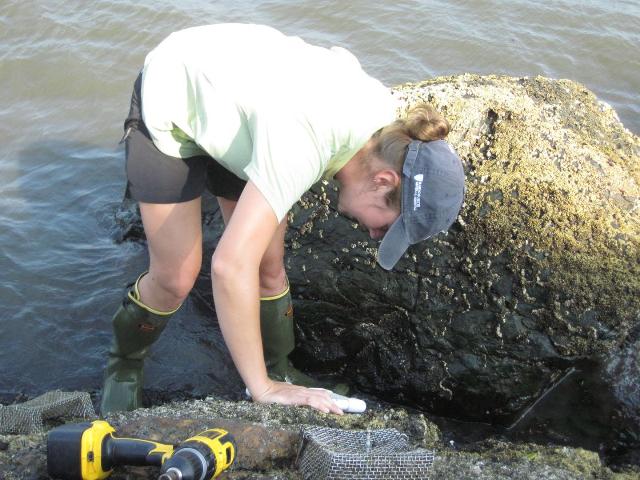Feb 2 2015
Ecologists sometimes look to mussel species, a well-studied and foundational genus in estuaries, as model organisms for assessing the condition of coastal habitats, which are crucial for people and well as the broader environment.
 Marcy Cockrell installs cages to protect mussels from predators. In Maine, mussels inside cages faired as well as mussels in the wild. In Long Island Sound and Narragansett Bay it was a different story. (Credit: Brown University)
Marcy Cockrell installs cages to protect mussels from predators. In Maine, mussels inside cages faired as well as mussels in the wild. In Long Island Sound and Narragansett Bay it was a different story. (Credit: Brown University)
But a new study in the journal Ecosphere suggests that the seemingly simple blue mussel, when studied on regional scale from Maine to Connecticut, harbors at least three specific mysteries that must be solved if the mollusks are to serve as the "canaries in the coal mine" of the Northeast coast.
"Mussels could indeed be a good sentinel species for rocky shores, but what our work suggests is that we need to know a lot more about how they behave in these different estuarine settings to use them as an indicator of ecosystem health," said conservation scientist and study senior author Heather Leslie, the Peggy and Henry D. Sharpe Assistant Professor of Environmental Studies.
For the study, Leslie and former students Marcy Cockrell and Joanna Bernhardt monitored and experimented with mussels at 18 sites in the Casco Bay of Maine, the Narragansett Bay of Rhode Island, and the Long Island Sound of Connecticut and New York in 2010 and 2011 (a region spanning about 600 kilometers of coastline). They measured the abundance of mussels both at adult and larval stages, studied the populations of neighboring rocky shore animals and marine algae, and tracked data on ecosystem factors such as water salinity, temperature, nutrients, oxygen, and local human population density. In the experiments, the team protected some mussels with cages to expose the effect that birds, crabs and other predators have on their numbers.
In the end, the research uncovered three intriguing mysteries of mussel life across the region, particularly in Casco Bay:
Generation gaps: Adults were populous but "recruitment" of young mussels from surrounding waters was low in Long Island Sound and Narragansett Bay. The opposite was true in Casco Bay. There, juvenile recruitment was high but adult populations were low. Few Maine predators: The cage experiments showed a significant role for mussel predators in Long Island Sound and Narragansett Bay, but not in Casco Bay. There, unprotected mussels fared about as well as the protected ones. Inner vs. outer: In each estuary, Leslie's team made measurements at sites nestled well within the bay, as well as at sites closer to the open ocean. Prior research suggested that higher levels of food within the bay would promote growth and abundance for the filter-feeding mussels (due to higher levels of nutrients and phytoplankton at the inner estuary sites). The study results were notably mixed across the whole region, however, providing little support for that hypothesis.
Explanations await further research. Genetic studies could determine, for example, whether the young mussels that are so abundant in Casco Bay may be floating up from the more southerly shores. If so, that suggests that mussel population dynamics can only be understood on regional (or multi-estuary) geographic scale.
Meanwhile, understanding why predator activity seems low in Casco Bay might require learning more about the local predator populations there. The findings could shed light on whether the ecosystem is in balance or other factors are at play.
"We did this because we want to understand how these systems work," Leslie said. "Given their accessibility and how well-studied they have been in other locations, rocky shores are logical sentinel ecosystems. They provide an opportunity to investigate how climate change and other more local-scale human activities are affecting New England's coast."
It may take more work to crack open the mussels' mysteries, but the stakes are high enough to make it worthwhile, Leslie said.